

HistoryNet. Suffragists picket the White House in 1917 to remind President Woodrow Wilson of his wartime pledge to fight for democratic principles.
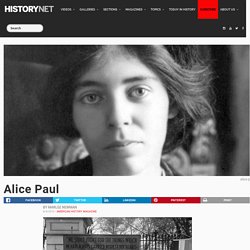
(Library of Congress) The National Woman Suffrage Procession of 1913 was the brainchild of New Jersey Quaker Alice Paul, fresh from years of study in England. Alice Paul Quotes - BrainyQuote. Alice Paul - Belmont-Paul Women's Equality National Monument (U.S. National Park Service) Alice Paul was one of the most prominent members of 20th-century women's rights movement.
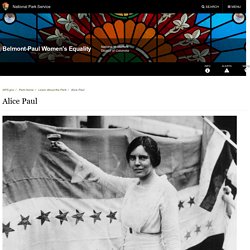
An outspoken suffragist and feminist, she tirelessly led the charge for women's suffrage and equal rights in the United States. Born to a New Jersey Quaker family in 1885, young Alice grew up attending suffragist meetings with her mother. She pursued an unusually high level of education for a woman of her time, graduating Swarthmore College in 1905 and receiving her master's in sociology in 1907 and a Ph.D. in economics in 1912 from the University of Pennsylvania.
While continuing her studies in England, she made the acquaintance of militant British suffragist Emmeline Pankhurst and her daughters, Christabel and Sylvia. Paul was arrested and imprisoned many times for her involvement with Pankhurst’s group, whose disruptive and radical tactics included smashing windows and prison hunger strikes.
Alice Paul Biography. Alice Paul was an early 20th century women’s rights activist who played a key role in the women’s suffrage movement that led to the passage of the 19th Amendment to the U.S.

Constitution in 1920. Born into a Quaker family, she had a comfortable upbringing. Her parents were strong supporters of gender equality and her mother was a member of the National American Woman Suffrage Association. Growing up, she imbibed her parents’ values, principles and beliefs which were reflected in her life’s work. From a young age she believed that one should do whatever they could for the betterment of the society. Childhood & Early Life. Today in History - January 11. Equality of Rights Under the Law Shall Not Be Denied or Abridged By the United States Or Any State On Account of Sex.
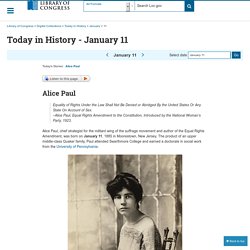
2651: American Women's Suffrage and Alice Paul. The demonstrators were women.

Their goal: a constitutional amendment giving women the right to vote. Alice Paul is having a moment: Column. Paul, Alice - National Women’s Hall of Fame. While earning degrees in law and social work, Alice Paul studied in London and joined the radical British suffrage movement.
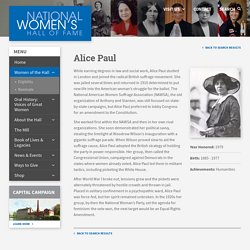
She was jailed several times and returned in 1910 determined to put new life into the American woman’s struggle for the ballot. The National American Women Suffrage Association (NAWSA), the old organization of Anthony and Stanton, was still focused on state-by-state campaigns, but Alice Paul preferred to lobby Congress for an amendment to the Constitution. She worked first within the NAWSA and then in her own rival organizations. She soon demonstrated her political savvy, stealing the limelight at Woodrow Wilson’s inauguration with a gigantic suffrage parade. Alice Stokes Paul (1885 - 1977) - Genealogy. Alice Paul was an American suffragist leader.

Along with her close friend Lucy Burns and others, she led a successful campaign for women's suffrage that resulted in the passage of the Nineteenth Amendment to the U.S. Constitution in 1920. In 1912, Alice Paul joined the National American Woman Suffrage Association (NAWSA) and was appointed Chairwoman of their Congressional Committee in Washington, DC After months of fundraising and raising awareness for the cause, membership numbers went up and in 1913 Alice Paul and Lucy Burns formed the Congressional Union for Women Suffrage. Their focus was lobbying for a constitutional amendment to secure the right to vote for women. Such an amendment had originally been sought by suffragists Susan B.
Alice Paul. Alice Paul, 1901.

Alice Stokes Paul (January 11, 1885—July 9, 1977) was the architect of some of the most outstanding political achievements on behalf of women in the 20th century. She was an American suffragist leader. Along with Lucy Burns (a close friend) and others, she led a successful campaign for women's suffrage that resulted in granting the right to vote to women in the U.S. federal election in 1920. Early Life. Unsung Heroes: Alice Paul. Alice Paul. Few people devote their entire lives to one cause as Alice Paul did.
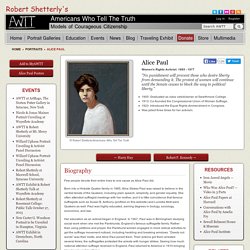
Born into a Hicksite Quaker family in 1885, Alice Stokes Paul was raised to believe in the central tenets of the Quakers, including plain speech, simplicity, and gender equality. She often attended suffragist meetings with her mother, and it is little coincidence that famous suffragists such as Susan B. Anthony (profiled on this website) and Lucretia Mott were Quakers as well. Paul was highly educated, earning degrees in biology, sociology, economics, and law. Her education as an activist began in England. Determined to get noticed, Paul organized a huge parade of women on March 3, 1913 to coincide with Woodrow Wilson’s presidential inauguration. Alice Paul - Women on 20s. Alice Paul (1885-1977) “There will never be a new world order until women are a part of it.”
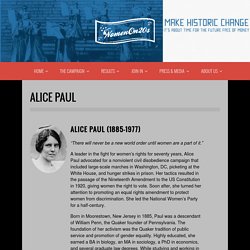
A leader in the fight for women’s rights for seventy years, Alice Paul advocated for a nonviolent civil disobedience campaign that included large-scale marches in Washington, DC, picketing at the White House, and hunger strikes in prison. Her tactics resulted in the passage of the Nineteenth Amendment to the US Constitution in 1920, giving women the right to vote. Soon after, she turned her attention to promoting an equal rights amendment to protect women from discrimination. She led the National Women’s Party for a half-century. Alice Paul: Champion of Woman Suffrage. The National Museum of American History and photographer Robert Weingarten are working in collaboration to build a historic portrait with help from the public. During the week of May 7-11, the museum will present five blogs about significant individuals in American history. Between May 11-28, visitors can vote on which of these historic figures they would most like to see depicted in the portrait.
Once a winner is announced, the public will have further opportunity to contribute to Weingarten’s unique process of visual biography. The finished portrait will be displayed at the Smithsonian this fall. This project is inspired by the exhibition Pushing Boundaries: Portraits by Robert Weingarten, on view July 2-October 14 at the Smithsonian’s International Gallery, Ripley Center on the National Mall. Alice Paul, suffragist and activist, in 10 facts. Ninety-four years ago today, the Nineteenth Amendment to the Constitution of the United States took effect, enshrining American women’s right to vote. Fifty years later, in the midst of a new wave of feminist activism, Congress designated 26 August as Women’s Equality Day in the United States. The 1971 Joint Resolution read, in part, “the women of the United States have been treated as second-class citizens and have not been entitled the full rights and privileges, public or private, legal or institutional, which are available to male citizens of the United States” and women “have united to assure that these rights and privileges are available to all citizens equally regardless of sex.”
For that reason, Congress was prevailed upon to declare 26 August a day to commemorate the the Nineteenth Amendment as a “symbol of the continued fight for equal rights.” Alice Paul was a pivotal and controversial figure in the last years of the American battle to win the vote for women. 1. 2. 3. 4. 5. Who Was Alice Paul - API. Raised in an area founded by her Quaker ancestors, Alice and her family remained devoted observers of the faith. As Hicksite Friends, the Paul family adhered to Quaker traditions of simplicity and plain speech (replacing you and yours with “thee” and “thy” when talking with other Quakers).
Alice attended a Hicksite school in Moorestown, New Jersey, and graduated first in her class in 1901. Hicksite Friends endorsed the concept of gender equality as a central tenet of their religion and a societal norm of Quaker life. As Paul noted years later, “When the Quakers were founded…one of their principles was and is equality of the sexes. So I never had any other idea…the principle was always there.” Alice Paul. American suffragist. Profile of American suffragist Alice Paul. When on January 10, 1917, Alice Paul challenged Woodrow Wilson to a political face-off, she was a day shy of 32, a slightly built New Jersey Quaker with a crown of dark hair and compelling violet-blue eyes--“great earnest childlike eyes that seem to seize you and hold you to her purpose,” wrote a supporter. “Suffragists Carry Fight to Gates of White House,” clamored the headlines.
Picketing the White House, a first in the annals of protest, capped a four-year campaign for a federal women’s suffrage amendment that had made Paul the country’s most controversial suffrage leader. But neither the parades she organized, nor the lobbying, demonstrations, publicity stunts, meetings, petitions, or electoral campaigns had won over hostile southern Democrats in Congress. Wilson, she strategized, held the key. Though a progressive Democrat, the Virginia-born president was no friend of suffrage. Little in her cloistered background hinted at the charismatic and clever tactician she had become. Fearless Radicalism: Alice Paul and Her Fight for Women’s Suffrage - Armstrong Undergraduate Journal of History.
National Woman's Party. Alice Paul - Civil Rights Activist, Women's Rights Activist. Alice Paul - Women’s History. Born into a Quaker family in Moorestown, New Jersey, Paul was raised in an intellectual and religious environment. Her forebears included on her mother’s side William Penn and on her father’s side the Winthrops of Massachusetts; her maternal grandfather was one of the founders of Swarthmore College. Paul graduated from Swarthmore in 1905 and then attended the New York School of Philanthropy (later Columbia University School of Social Work), the University of Pennsylvania, and a training school for Quakers in Woodbridge, England. She remained in England from 1907 to 1910. It was during those years that Paul, while studying and working as a case worker for a London settlement house, served her apprenticeship for what became her vocation: the struggle for women’s rights. She was enlisted by England’s militant suffragists Emmeline and Christobel Pankhurst.
National History Day. National History Day in Wisconsin. Contest Rule Book.